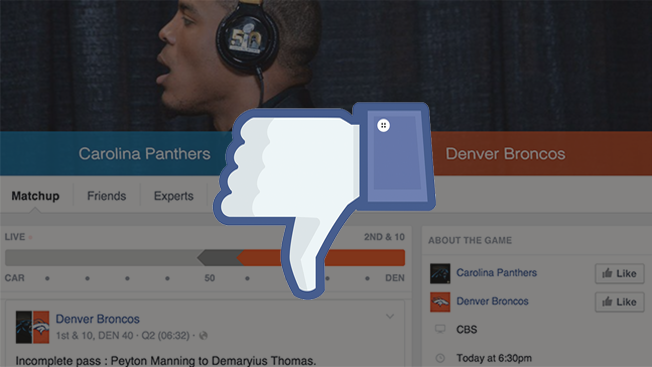Facebook’s Sports Stadium Didn’t Impress Cell Phone Users During Super Bowl
Facebook’s Super Bowl feature Sports Stadium really didn’t impress sports fans with cell phones. In fact, users are airing frustrations on Twitter. Facebook just Launched Its own version of Twitter’s Moments, but just for sports social giant hits the gridiron imitation game between Facebook and Twitter continues. For many sports fans, simultaneously watching Twitter and […]
Facebook’s Super Bowl feature Sports Stadium really didn’t impress sports fans with cell phones. In fact, users are airing frustrations on Twitter.
Facebook just Launched Its own version of Twitter’s Moments, but just for sports social giant hits the gridiron imitation game between Facebook and Twitter continues.
For many sports fans, simultaneously watching Twitter and a game goes together like salsa and chips. But with interest in Twitter on the downswing and its struggle to add users and captivating features prompted Facebook be creative.
The battle of Facebook and Twitter for sports fans.
The two social media companies battled it during Super Bowl Sunday with new “second-screen” features that they say enhance the TV-watching experience. The goal: Getting more eyeballs onto their services during the most-watched U.S. sports game of the year. And of course, score more advertising dollars.
Sports Stadium enters the field and cell phones.
Facebook tested its new Sports Stadium for the football battle. The Zuckerberg company created a playbook to run sports chatter away from Twitter.
On Twitter, users clicked the lightning bolt icon at the top of the app and were led to a section with a highlight reel of Super Bowl tweets. Writing “#SB50,” short for Super Bowl 50, in a post automatically added a football graphic to the message, making it more noticeable and easier for the company to sort. Tweets with “#Broncos” and “#KeepPounding” (a Panthersslogan) generate team logos.
That’s how it was supposed to work.
Things didn’t go as planned for Sports Stadium. Facebook stumbled early in its attempt to capture real-time conversation during Super Bowl 50. There were some major hiccups during the critical first half of the game.
For example, the Denver Broncos scored the first points of the game with a field goal at about 6:49 EST. However, Sports Stadium on desktop failed to show a score update until about 10 minutes later. Additionally, for some users, the desktop version said that the game started at 7 p.m. Even with all the articles that were written and shared to Facebook, for some reason, Facebook could not properly answer, “What time is the Super Bowl?
Facebook’s loss was Twitter’s gain.
Many users who tried Sports Stadium ended up turning to Twitter to voice their frustrations. Aside from having trouble staying with the action, some people tweeted that they were underwhelmed with the amount of actual conversation about the game.
Much of the problem during the first half was because of so many users. But come on Facebook, you knew how many people use Facebook and are sports fans.
Facebook’s Sports Stadium is no threat yet to Twitter’s live event dominance.
Sports fans are constantly plugged into the game. But they aren’t just checking in for score updates or breaking news, they also want to talk about the game, check out action photos, and ultimately advocate for their team. They are watching TV and using their cell phone.
Keeping up with the action.
To keep cell phones fully charged, many stadiums and sports bars rent or purchase a device charging solution. This amenity offers a clever way to ensure guest happiness, no matter which team wins. Companies like Veloxity offer a full suite of device charging solutions for any bar, restaurant or venue to purchase or rent.
